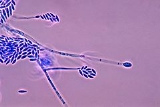
Fusarium
Overview
Fusarium is a large genus of filamentous
fungi widely distributed in soil and in association with plants. Most species are harmless saprobes, and are relatively abundant members of the soil microbial community. Some species produce mycotoxins in cereal crops that can affect human and animal health if they enter the food chain. The main toxins produced by these Fusarium species are fumonisins
and trichothecenes.
The name of Fusarium comes from Latin fusus, meaning a spindle
.
The genus includes a number of economically important plant pathogen
ic species.
Fusarium graminearum commonly infects barley if there is rain late in the season.
Hypha
A hypha is a long, branching filamentous structure of a fungus, and also of unrelated Actinobacteria. In most fungi, hyphae are the main mode of vegetative growth, and are collectively called a mycelium; yeasts are unicellular fungi that do not grow as hyphae.-Structure:A hypha consists of one or...
fungi widely distributed in soil and in association with plants. Most species are harmless saprobes, and are relatively abundant members of the soil microbial community. Some species produce mycotoxins in cereal crops that can affect human and animal health if they enter the food chain. The main toxins produced by these Fusarium species are fumonisins
Fumonisins
A fumonisin is a mycotoxin derived from Fusarium.More specifically, it can refer to:* Fumonisin B1* Fumonisin B2...
and trichothecenes.
The name of Fusarium comes from Latin fusus, meaning a spindle
Spindle
The term spindle may refer to:In textiles and manufacturing:*Spindle , a device to spin fibres into thread*Spindle , is the main rotating part of a machine tool, woodworking machine, etc...
.
The genus includes a number of economically important plant pathogen
Pathogen
A pathogen gignomai "I give birth to") or infectious agent — colloquially, a germ — is a microbe or microorganism such as a virus, bacterium, prion, or fungus that causes disease in its animal or plant host...
ic species.
Fusarium graminearum commonly infects barley if there is rain late in the season.
Unanswered Questions

